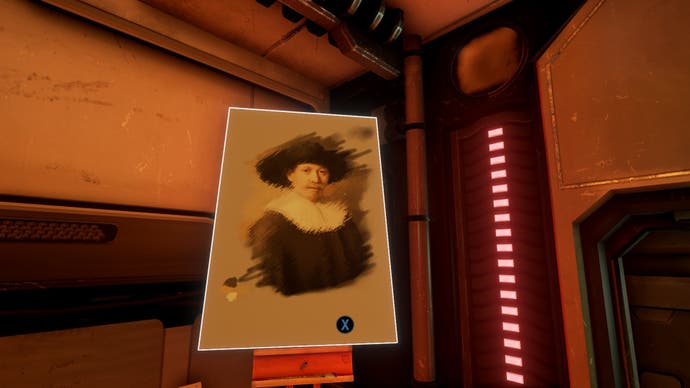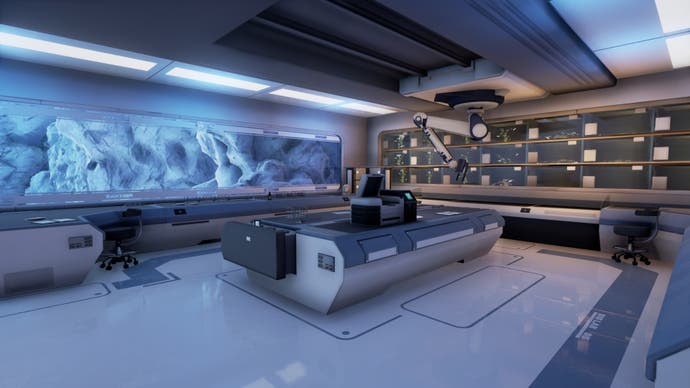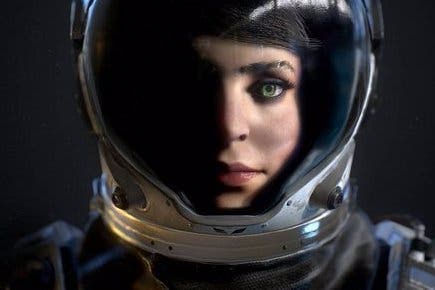The Turing Test review
Alan in the universe?
In a room in one of the crew's quarters, I saw a familiar face staring back at me from an easel. It was a Rembrandt, or rather it was the Next Rembrandt. Stuck in the middle of The Turing Test, I think this counts as a joke.
The Next Rembrandt isn't really a Rembrandt, after all. It's a computer-generated Rembrandt-alike, constructed from data regarding actual Rembrandts as a publicity stunt for a Dutch multinational banking and financial services corporation. If that doesn't sound Blue Ant enough for you, get this: The Next Rembrandt is a median Rembrandt. It's crunched the stats on many existing Rembrandts, from pose choice and clothing elements to facial geometry, and it's then been put together based on a sort of midpoint of all the data. It is a Rembrandt reduction, concentrated from stewing in all that rich Rembrandt goodness. From the little I've read, the team behind all this often seems a touch cagey about how much human involvement was needed, but when the Next Rembrandt was unveiled, the headlines were mostly saying the same kinds of things anyway: An AI thinks it can paint a Rembrandt?! (For what it's worth, I quite like the results.)
It crops up in The Turing Test because The Turing Test, as the name suggests, is very concerned with AI. The original Turing Test has entered popular culture now: an experiment into AI development in which a computer and a human will hold a conversation over a text channel while an observer reads the transcript and tries to guess which participant is human and which isn't. As far as I gather, this has rather been put aside these days, since the Turing Test as originally conceived isn't testing a computer's ability to think so much as its ability to mimic - or, if you prefer, deceive. All of this gets an airing in the game that I've just spent the last few days playing - and they've been very pleasant days. This Turing Test is a first-person 3D puzzler built of around 70 room escape scenarios, clipped together and with a bit of narrative threaded in between. It's clever and challenging and glossy and pretty and it wants to leave you with something to think about. It is pretty successful.
After the classical splendour of developer Bulkhead's last game, Pneuma: Breath of Life, the setting's changed a bit, although the focus on philosophical enquiry remains. We're off to Europa, where a science mission deep in the ancient ice has gone awry. You play as Ava Turing - which is handy, isn't it? - a member of the team who is sent down from orbit to investigate why everyone on the ground seems to have disappeared. Your companion for this trip is an AI called TOM. (I'll call him Tom from here on out so it doesn't look like I'm shouting at him.) Like all AIs in games, Tom has a magnificent voice - this one's a sort of Next Rembrandt job where the key data points were provided by Benedict Cumberbatch and Tom Baker - and like all AIs in games, he feels rather untrustworthy. Or is he? Or is he?

Or is he? Anyway, it's handy that Tom's come along for the ride, because the ground team have done something quite odd. They've taken their IKEA-like flat-pack Europa base and completely reconfigured it into a series of test chambers. Turing Test chambers, Tom informs us: tests designed so that a human can complete them but an AI can't. This, apparently, is because these tests require creativity to solve. Human creativity. Seems like the ground team want to keep Tom at bay.
I worried, at this point, that the ground team might be keeping me at bay, too. I'm not always very good at puzzles and, to tell the truth, I'm a bit iffy at creativity in general. Luckily, The Turing Test is basically setting its sights on someone exactly like me. If you are after a really tricky puzzle game, you might want to look elsewhere - although some of the optional rooms that reward you with additional insights into the story can be wonderfully devious. The Turing Test's main emphasis, I think, is on providing puzzles that establish ideas and then build on them in ingenious but playful ways. They're witty and, generally, fairly compact, and while they all have the same objective - get to the exit door and open it, and then proceed to the next set of chambers and do it all over again - they offer plenty of incidents of delightful surprise. There is a lot of silent nudging going on, I think: this is the sort of game that doesn't want to stump you, but doesn't want you to brute force things either. The Turing Test's aiming for the holy grail of puzzle games: it wants you to have that priceless moment when everything suddenly clicks for you, and you see exactly what you have to do, and you feel a bit smug about it.
I've read a lot of things suggesting that The Turing Test is a bit like Portal. In truth, it looks like Portal, with its sterile sci-fi chambers, its glossy white expanses riddled with cables (all delivered rather beautifully with Unreal Engine 4), but it's made of much simpler parts and it plays things much straighter. There's nothing so inherently brain-stretching as a portal gun, and it's morality rather than geometry that goes under the knife. The tools from which the Turing Test's puzzles are constructed are actually pretty simple, in fact. Doors play a huge role, and so do keys, of which there are two basic types, both of which fit the same universal lock. One key is a block that can be placed in the lock by hand, and which can also be used as a physics object, to weigh down pressure plates, say, or block light beams. The only problem with this key is that once you've stuck it in the lock, to get it out again you need to be right in front of it - so if you use it to open a door, you can't then use it to open another door.

This is where the second key comes in. It's a glowing plasma orb of some kind, and you manipulate it with an object that looks a bit like a gun - presumably so that some Steam browsers will glance at the screenshots without investigating too deeply and buy The Turing Test by accident. The gun allows you to pull this second type of key out of locks from a distance - and fire it into distant locks. So you have two keys, one of which depends on proximity, and the other of which depends on line of sight. Even before the game's started to mix up that second key with different coloured plasma balls with different qualities, it has a lot of fun with these basic components. A simple puzzle might have you unlocking a door with the plasma orb, and then finding another locked door on the other side. The trick in this case might involve tracking around to a window that gives you a glimpse of the orb you just placed in the first lock. Grab it with your gun and use it in the second door. Done!
Things are rarely this straightforward, mind - especially since the locks don't just open doors. They trigger moving platforms, or bring bits of machinery to life. Cables play a role too - cables that light up as you give them power, and which must be tracked across the landscape if you want to see what they're actually connecting. Once you have cables you can have junction boxes, with certain junctions that only trigger machinery or open doors once the power has been cut. The Turing Test keeps all this stuff simple - you'll never have to do anything that feels like actual programming here - but it is extremely inventive. Its puzzles often have a kind of internal narrative to them, with distinct stages.
But - crucially - they don't have much in the way of backtracking. Puzzles frequently span multiple rooms, but they're never a faff to navigate, and I never got to the point where I could see what I had to do but I didn't have the mental energy to put it into practice. On top of that, once an idea has been implemented and then subverted, something new comes along to make you see the old bits and pieces you've been messing with in a new light once again. Subversion via addition. Just over halfway through the game's seven chapters, in fact, a really huge change occurs, and you suddenly have a whole new way of looking at even the simplest of interactions. This never feels like drudgery. As the puzzle vocabulary increases, the game becomes more creative rather than becoming increasingly pedantic.

In between the puzzles you get little bits of narrative, as Ava chats to Tom and starts to figure out what's taken place on this strange Jovian moon. After every ten puzzles, you get to visit part of the station that isn't devoted to puzzles at all - the crew quarters, say, or a laboratory looking out onto the ice. Many of the game's biggest narrative moments involve audio logs, sadly, which sort of kills the dramatic pacing. Even so, while the story being told initially seems earnest rather than truly engrossing, it's another clever piece of design, layering on ambiguity until you're left connecting most of the dots yourself.
Best of all, its themes start to blend with the ideas that emerge through the puzzles themselves, via sacrifice, say, or instances in which the only thing to do seems implausibly low-tech and slightly stupid. Throw in the moment-to-moment revelations that are beautifully crafted into each individual challenge, and you have something quite special. The Turing Test may look austere but there is a wonderful wit and warmth to the way it's been constructed. It's very - what's the word? - human.


